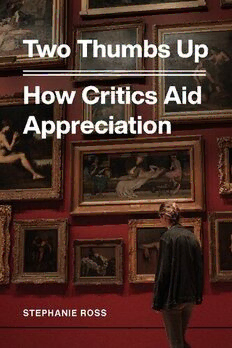
Two Thumbs Up: How Critics Aid Appreciation PDF
Preview Two Thumbs Up: How Critics Aid Appreciation
Two Thumbs up Two Thumbs Up how CriTiCs Aid AppreCiATion Stephanie Ross The University of Chicago Press ChiCAgo And London The University of Chicago Press, Chicago 60637 The University of Chicago Press, Ltd., London © 2020 by The University of Chicago All rights reserved. No part of this book may be used or reproduced in any manner whatsoever without written permission, except in the case of brief quotations in critical articles and reviews. For more information, contact the University of Chicago Press, 1427 E. 60th St., Chicago, IL 60637. Published 2020 Printed in the United States of America 29 28 27 26 25 24 23 22 21 20 1 2 3 4 5 isbn- 13: 978- 0- 226- 06428- 4 (cloth) isbn- 13: 978- 0- 226- 70503- 3 (e- book) doi: https:// doi .org /10 .7208 /chicago /9780226705033 .001 .0001 Library of Congress Cataloging-in-Publication Data Names: Ross, Stephanie, author. Title: Two thumbs up : how critics aid appreciation / Stephanie Ross. Description: Chicago : University of Chicago, 2020. | Includes bibliographical references and index. Identifiers: LCCn 2019053421 | isbn 9780226064284 (cloth) | isbn 9780226705033 (ebook) Subjects: LCsh: Hume, David, 1711–1776. | Art appreciation. | Aesthetics. | Art—Philosophy. | Art criticism. Classification: LCC N75 .R67 2020 | ddC 701/.18—dc23 LC record available at https://lccn.loc.gov/2019053421 ♾ This paper meets the requirements of Ansi/niso Z39.48- 1992 (Permanence of Paper). Contents Preface vii Introduction 1 1 · Taste and Preference 8 2 · Aesthetic Qualities 29 3 · Hume on the Standard of Taste 61 4 · Identifying Critics 83 5 · When Critics Disagree 107 6 · Comparing and Sharing Taste 134 7 · Some Applications 159 Appendix: A Checklist for Appreciation 203 Acknowledgments 205 Notes 207 Bibliography 239 Index 245 Preface My first book, What Gardens Mean (University of Chicago Press, 1998), was an exercise in landscape aesthetics. It allowed me to happily think about gardens’ powers and their status as art. It was also one of those rare phil- osophical projects that required its author to travel. For quite some time thereafter, I cast about for a suitable follow- up. The project I eventually chose is summarized by my subtitle, “How Critics Aid Appreciation.” I found myself drawn to an interconnected set of issues that emerged as I repeatedly taught and pondered two key essays: “Aesthetic Concepts,” published by Frank Sibley in 1959; and “Of the Standard of Taste,” pub- lished by David Hume some two hundred years earlier. Between them these pieces raise compelling questions about how we engage with works of art and about whether some individuals are specially situated to serve as guides. Concerns about aesthetic realism and the objectivity of aesthetic claims are ever- present in the background. My aim has been to write for a broad audience in addressing these questions— not just professional philosophers and philosophy students, but also humanists, generalists, art enthusiasts, autodidacts, and more. I examine a rich set of issues here. Since readers might want to pick and choose, pursuing some of the topics I take up but skipping others, I have prefaced each chapter with a précis that indicates its content. I have also created a brief appendix with a suggested checklist for appreciation. Ex- amining it will allow readers to consider their own critical practice. Introduction Consider the careers of film critics Gene Siskel and Roger Ebert. Starting with the 1975 debut of Opening Soon at a Theater Near You on their local Chicago PBS affiliate, they held forth until Siskel’s death in 1999, rating films and entertaining an ever- growing audience with their opinionated analysis and captivating banter. They transitioned from print to electronic media (both began as film critics for Chicago daily papers) and presided over increasingly ambitious iterations of that first local show.1 At the height of their popularity, Siskel and Ebert were said to reach 95 percent of the nation with their reviews.2 Their personal relationship was competitive and rancorous. A 2013 retrospective published in Slate magazine compares their interactions to “a peevish marriage” and notes that tapings of the half- hour show would often take four to six hours because the two stars argued so vociferously about every little thing.3 I take away two important morals from this brief history. First, Siskel and Ebert’s long reign shows that arguing about art is both entertaining and engrossing. And second, they perfected a way to give aesthetic ad- vice to a mass audience. There was a predictable structure to Siskel and Ebert’s programs. Generally several films were reviewed. The critics took turns leading the discussions. They called attention to details of character and plot, discussed nuances of acting, noted tone and mood, unpacked special effects. They also offered illuminating comparisons, ranking the current film against other work by the same artists and similar work by others. Short clips were shown throughout to support these various claims. As Siskel and Ebert’s high ratings attest, this formula made for a very popular show. Viewers get a good sense of each of the films being rated. The fact that each segment offers evaluative claims about a film together
